Removal
| •
|
Use fender covers to avoid damaging painted
surfaces.
|
| •
|
To avoid damaging the cylinder head, wait
until the engine coolant temperature drops below normal temperature
before removing it.
|
| •
|
When handling a metal gasket, take care not
to fold the gasket or damage the contact surface of the gasket.
|
| •
|
To avoid damage, unplug the wiring connectors
carefully while holding the connector portion.
|
|
|
Mark all wiring and hoses to avoid misconnection.
|
|
In case of removing the high pressure fuel pump,
high pressure fuel pipe, delivery pipe, and injector, there may be injury
caused by leakage of the high pressure fuel. So don’t do any repair
work right after engine stops.
|
|
1. |
Remove the intake manifold.
|
|
2. |
Remove the exhaust manifold.
|
|
3. |
Remove the cylinder head cover.
|
|
4. |
Remove the timming chain cover.
|
|
5. |
Remove the timming chain.
|
|
6. |
Remove the high pressure fuel pump bracket(A).
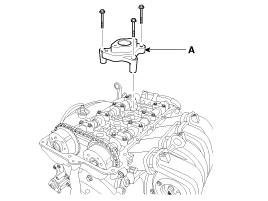
|
|
7. |
Remove the cmashaft.
|
(1) |
Remove the front camshaft bearing cap (A)
with the upper bearing (B).
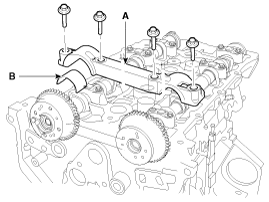
|
|
(2) |
Remove the camshaft bearing cap (A) in the
sequence shown.
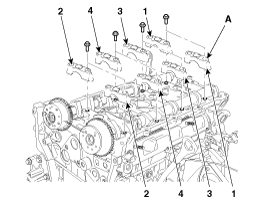
|
|
(3) |
Remove the camshafts (A).
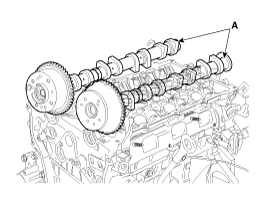
|
|
|
8. |
Remove the intake OCV (Oil control valve) (A) using
a torx wrench.
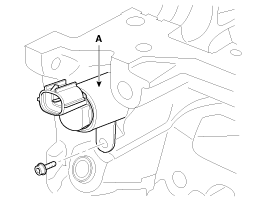
|
|
9. |
Remove the exhaust OCV (Oil control valve) (A) using
a torx wrench.
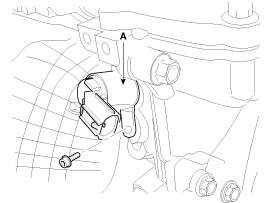
|
|
10. |
Remove the intake CMPS (Camshaft position sensor)
(A).
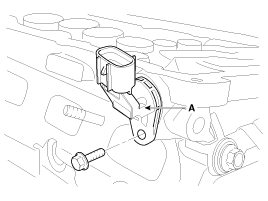
|
|
11. |
Remove the exhaust CMPS (Camshaft position sensor)
(A) after removing the engine hanger (B).
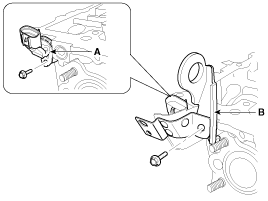
|
|
12. |
Remove the injector & rail module (A).
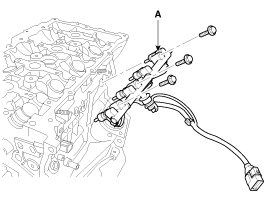
|
|
13. |
Remove the cylinder head.
|
(1) |
Using triple square wrench, uniformly loosen
and remove the 10 cylinder head bolts, in several passes, in
the sequence shown. Remove the 10 cylinder head bolts and plate
washers.
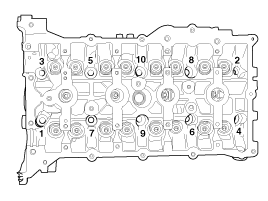
|
Head warpage or cracking could result
from removing bolts in an incorrect order.
|
|
|
(2) |
Lift the cylinder head (A) from the dowels
on the cylinder block and place the cylinder head on wooden
blocks on a bench.
|
Be careful not to damage the contact
surfaces of the cylinder head and cylinder block.
|
|
|
(3) |
Remove the cylinder head gasket (B).
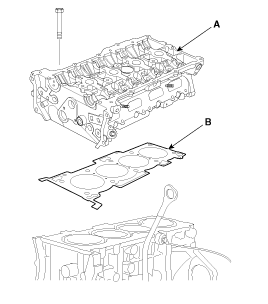
|
|
Disassembly
|
Identify MLA(Mechanical Lash Adjuster), valves, valve
springs as they are removed so that each item can be reinstalled in
its original position.
|
|
1. |
Remove the MLAs (A).
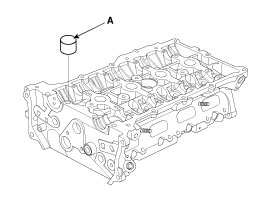
|
|
2. |
Remove the valves.
|
(1) |
Using SST (09222-3K000, 09222-3K100), compress
the valve spring and remove retainer lock.
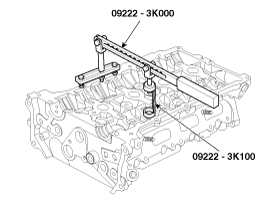
|
|
(2) |
Remove the spring retainer.
|
|
(3) |
Remove the valve spring.
|
|
(5) |
Using needle-nose pliers, remove the valve
stem seal.
|
Do not reuse old valve stem seals.
|
|
|
Inspection
Cylinder Head
|
1. |
Inspect for flatness.
Using a precision straight edge and feeler gauge,
measure the surface the contacting the cylinder block and the manifolds
for warpage.
Flatness of cylinder
head gasket surface
Standard : Less than 0.05 mm (0.0019 in.)
for total area
Less than 0.02 mm (0.0007 in.) for a section
of 100 mm (3.9370 in.) X 100 mm (3.9370 in.)
Flatness of manifold
mounting surface (Intake/Exhaust)
Standard : Less than 0.10 mm (0.0039 in.)
|
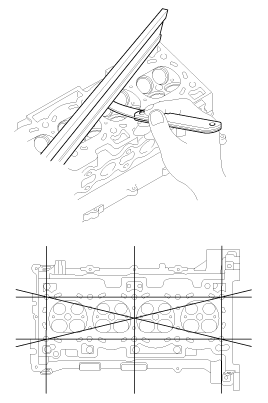
|
|
2. |
Inspect for cracks.
Check the combustion chamber, intake ports, exhaust
ports and cylinder block surface for cracks. If cracked, replace the
cylinder head.
|
Valve And Valve Spring
|
1. |
Inspect valve stems and valve guides.
|
(1) |
Using a caliper gauge, measure the inside
diameter of the valve guide.
Valve guide
inner diameter
Intake / Exhaust :
5.500 ~ 5.512 mm (0.21654 ~ 0.21701
in.)
|
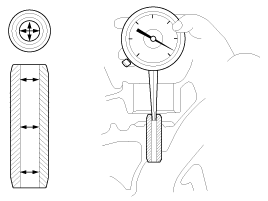
|
|
(2) |
Using a micrometer, measure the diameter
of the valve stem.
Valve stem
outer diameter
Intake : 5.465 ~ 5.480 mm (0.21516
~ 0.21575 in.)
Exhaust : 5.458 ~ 5.470 mm (0.214988
~ 0.21535 in.)
|
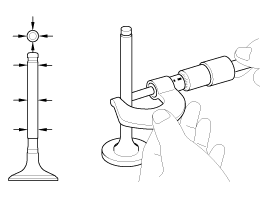
|
|
(3) |
Subtract the valve stem diameter measurement
from the valve guide inside diameter measurement.
Valve stem-to-guide
clearance
[Standard]
Intake : 0.020 ~ 0.047 mm (0.00078
~ 0.00185 in.)
Exhaust : 0.030 ~ 0.054 mm (0.00118
~ 0.00212 in.)
[Limit]
Intake : 0.070 mm (0.00275 in.)
Exhaust : 0.090 mm (0.00354 in.)
|
If the clearance is greater than maximum,
replace the valve or cylinder head.
|
|
|
2. |
Inspect the valves.
|
(1) |
Check the valve is ground to the correct
valve face angle.
|
|
(2) |
Check that the surface of the valve for wear.
If the valve face is worn, replace the valve.
|
|
(3) |
Check the valve head margin thickness.
Valve head
thickness (Margin)
[Standard]
Intake : 1.02 mm(0.0401 in.)
Exhaust : 1.09 mm(0.0429 in.)
|
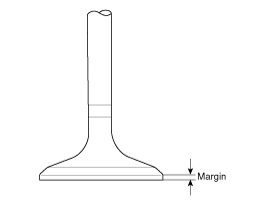
If the margin thickness is less than minimum,
replace the valve.
|
|
(4) |
Check the valve length.
Valve length
[Standard]
Intake : 113.18 mm (4.4559 in.)
Exhaust : 105.84 mm (4.1669 in.)
[Limit]
Intake : 112.93 mm (4.4461 in.)
Exhaust : 105.59 mm (4.1571 in.)
|
|
|
(5) |
Check the surface of the valve stem tip for
wear.
If the valve stem tip is worn, replace the
valve.
|
|
|
3. |
Inspect the valve seats
|
(1) |
Check the valve seat for evidence of overheating
and improper contact with the valve face. Replace the cylinder
head if necessary.
|
|
(2) |
Check the valve guide for wear. If the valve
guide is worn, replace the cylinder head.
|
|
|
4. |
Inspect the valve springs.
|
(1) |
Using a steel square, measure the out-of-square
of the valve spring.
|
|
(2) |
Using a vernier calipers, measure the free
length of the valve spring.
Valve spring
[Standard]
Free height : 47.44 mm (1.8677 in.)
Out-of-square : Less than 1.5°
|
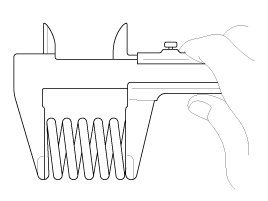
If the free length is not as specified, replace
the valve spring.
|
|
MLA (Mechanical Lash Adjuster)
|
1. |
Inspect the MLA.
Using a micrometer, measure the MLA outside diameter.
MLA outer diameter
:
31.964 ~ 31.980 mm (1.2584 ~ 1.2590 in.)
|
|
|
2. |
Using a caliper gauge, measure MLA tappet bore inner
diameter of cylinder head.
Tappet bore inner
diameter :
32.000 ~ 32.025 mm (1.2598 ~ 1.2608 in.)
|
|
|
3. |
Subtract MLA outside diameter measurement from tappet
bore inside diameter measurement.
MLA to tappet bore
clearance
[Standard] : 0.020 ~ 0.061 mm (0.00078 ~
0.00240 in.)
[Limit] : 0.070 mm (0.00275 in.)
|
|
Reassembly
|
Thoroughly clean all parts to be assembled.
Before installing the parts, apply fresh engine oil
to all sliding and rotating surfaces.
Replace oil seals with new ones.
|
|
1. |
Install valves.
|
(1) |
Using SST(09222-4A000), push in a new oil
seal.
|
Do not reuse old valve stem seals.
Incorrect installation of the seal
could result in oil leakage past the valve guides.
|
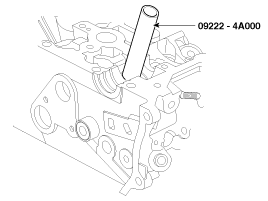
|
|
(2) |
Install the valve, valve spring and spring
retainer.
|
Place valve springs so that the side
coated with enamel faces toward the valve spring retainer
and then installs the retainer.
|
|
|
(3) |
Using the SST(09222-3K000, 09222-3K100),
compress the spring and install the retainer locks. After installing
the valves, ensure that the retainer locks are correctly in
place before releasing the valve spring compressor.

|
|
(4) |
Lightly tap the end of each valve stem two
or three times with the wooden handle of a hammer to ensure
proper seating of the valve and retainer lock.
|
|
|
2. |
Install the MLAs after appling engine oil.
Check that the MLA rotates smoothly by hand.

|
MLA can be reinstalled in its original position.
However, the valve lash clearances must be
rechecked and adjusted accordingly before the cylinder head
is installed onto the cylinder block.
Refer to General information in EM section
for Valve Clearance checking and adjustment procedure.
|
|
Installation
| •
|
Thoroughly clean all parts to be assembled.
|
| •
|
Always use a new head and manifold gasket.
|
| •
|
The cylinder head gasket is a metal gasket.
Take care not to bend it.
|
| •
|
Rotate the crankshaft, set the No.1 piston
at TDC.
|
|
|
1. |
Install the cylinder head gasket (A) on the cylinder
block.
|
• |
Be careful of the installation direction.
|
|
• |
Apply liquid gasket (Loctite 5900H
or equivalent) on the edge of cylinder head gasket upside
and downside. (At the position 'B')
|
|
• |
After applying sealant, assemble
the cylinder head in five minutes.
|
|
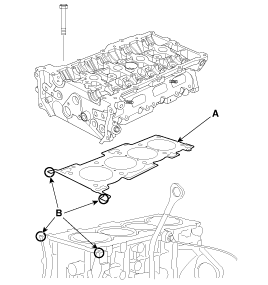
|
|
2. |
Place the cylinder head carefully in order not to
damage the gasket with the bottom part of the end.
|
|
3. |
Install cylinder head bolts.
|
(1) |
Do not apply engine oil on the the cylinder
head bolts.
|
|
(2) |
Using the SST(09221-4A000), tighten the cylinder
head bolts and plate washers, in several passes, in the sequence
shown.
|
Tightening torque
:
32.4 ~ 36.3 N.m (3.3 ~ 3.7 kgf.m, 23.9 ~
26.8 lb-ft) + 90 ~ 95° + 90 ~ 95°
|
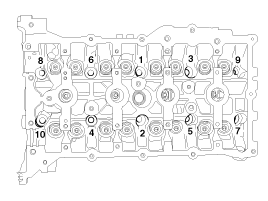
|
Always use new cylinder head bolt.
|
|
|
4. |
Install the injector & rail module (A).
Pre-tighten the bolts and then tighten the bolts
with the specified torque in the sequence shown.
Tightening torque
:
18.6 ~ 23.5 N.m (1.9 ~ 2.4 kgf.m, 13.7 ~
17.4 lb-ft)
|
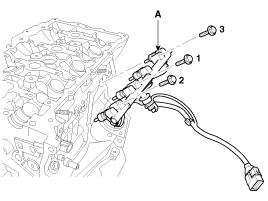
|
|
5. |
Install the intake CMPS (Camshaft position sensor)
(A).
Tightening torque
:
9.8 ~ 11.8 N.m (1.0 ~ 1.2 kgf.m, 7.2 ~ 8.7
lb-ft)
|

|
|
6. |
Install the exhaust CMPS (Camshaft position sensor)
(A) and the engine hanger (B).
Tightening torque
Sensor bolt:
9.8 ~ 11.8 N.m (1.0 ~ 1.2 kgf.m, 7.2 ~ 8.7
lb-ft)
Engine hanger bolt:
27.5 ~ 31.4 N.m (2.8 ~ 3.2 kgf.m, 20.3 ~
23.1 lb-ft)
|

|
|
7. |
Install the intake OCV (Oil control valve) (A).
Tightening torque
:
9.8 ~ 11.8 N.m (1.0 ~ 1.2 kgf.m, 7.2 ~ 8.7
lb-ft)
|

|
|
8. |
Install the exhaust OCV (Oil control valve) (A).
Tightening torque
:
9.8 ~ 11.8 N.m (1.0 ~ 1.2 kgf.m, 7.2 ~ 8.7
lb-ft)
|

|
• |
Do not reuse the OCV when dropped.
|
|
• |
Keep the OCV filter clean.
|
|
• |
Do not hold the OCV sleeve during
servicing.
|
|
• |
When the OCV is installed on the
engine, do not move the engine with holding the OCV
yoke.
|
|
|
|
9. |
Install the cmashaft.
|
(1) |
Install the exhaust camshaft lower bearing
(A).
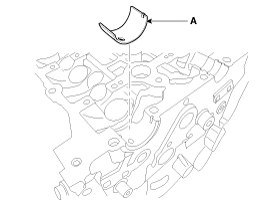
|
|
(2) |
Install the camshafts (A).

|
|
(3) |
Install the exhaust camshaft upper bearing
(A) to the front bearing cap.
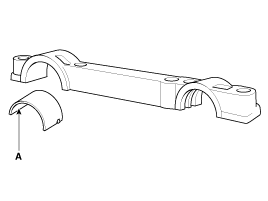
|
|
|
10. |
Install camshaft bearing caps (A) in their proper
locations.
Tightening order
Group A → Group B → Group C.
Tightening torque
:
Step 1
M6 : 5.9 N.m (0.6 kgf.m, 4.3 lb-ft)
M8 : 14.7 N.m (1.5 kgf.m, 10.8 lb-ft)
Step 2
M6 : 10.8 ~ 12.7 N.m (1.1 ~ 1.3 kgf.m, 8.0
~ 9.4 lb-ft)
| |
Components 1. Cylinder head 2. Intake OCV (Oil Control Valve) 3. Exhaust OCV (Oil Control Valve) 4. MLA 5. Retainer lock 6. Retainer 7. Valve spring 8. Valve stem seal 9. Valve ...
See also:
Auto defogging system
Auto defogging reduces the probability of fogging up the inside of the windshield by automatically sensing the moisture of inside the windshield. The auto defogging system operates when the heater or ...
Instrument cluster
Type A Type B 1. Tachometer 2. Speedometer 3. Engine coolant temperature gauge 4. Fuel gauge 5. LCD display 6.Warning and indicator lights (if equipped) 7. Turn signal indicator lights ❈ The actual ...
Outside lamp
1. Open the tailgate. 2. Remove the service cover using a flat-blade screwdriver. 3. Loosen the lamp assembly retaining please verify. 4. Remove the rear combination lamp assembly from the body of the ...
 Hyundai Santa Fe (DM): Cylinder Head. Repair procedures
Hyundai Santa Fe (DM): Cylinder Head. Repair procedures Cylinder Head. Components and Components Location
Cylinder Head. Components and Components Location Cylinder Block
Cylinder Block























